Carolingian is an adjective applied to topics concerning or in the time of the Carolingian dynasty in medieval history. Secondarily it can mean developments only in the time of Charlemagne. Carolingian has been applied to:
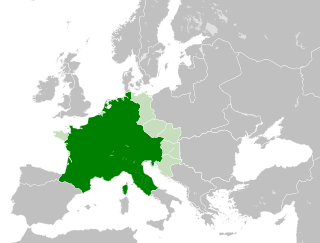
The Carolingian Empire (800–888) was a large Frankish-dominated empire in western and central Europe during the Early Middle Ages. It was ruled by the Carolingian dynasty, which had ruled as kings of the Franks since 751 and as kings of the Lombards in Italy from 774. In 800, the Frankish king Charlemagne was crowned emperor in Rome by Pope Leo III in an effort to transfer the Roman Empire from east to west. The Carolingian Empire is considered the first phase in the history of both the Holy Roman Empire, which lasted until 1806, and France.
Pippin or Pepin is a masculine given name of Frankish origin with uncertain meaning. The name was borne by various members of the Carolingian family that ruled the Austrasian Empire in the Middle Ages, in what is now France and the western parts of Germany; most notably Pepin the Short, the first Carolingian king of the Franks and father of Charlemagne. Other variations of the name include Pipin, Pépin (French), Pippen, Pepijn (Dutch), Peppino or Pepino (Italian), and Pepe (Spanish).

The Carolingian Renaissance was the first of three medieval renaissances, a period of cultural activity in the Carolingian Empire. It occurred from the late 8th century to the 9th century, taking inspiration from the Christian Roman Empire of the fourth century. During this period, there was an increase of literature, writing, the arts, architecture, jurisprudence, liturgical reforms, and scriptural studies.
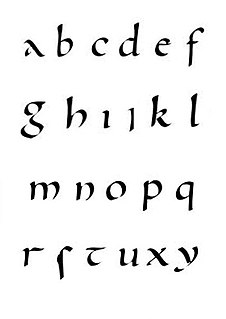
Carolingian minuscule or Caroline minuscule is a script which developed as a calligraphic standard in the medieval European period so that the Latin alphabet of Jerome's Vulgate Bible could be easily recognized by the literate class from one region to another. It is thought to have originated before AD 778 at the scriptorium of the Benedictine monks of Corbie Abbey, about 150 km (93 mi) north of Paris, and then developed by Alcuin of York for wide use in the Carolingian Renaissance. Alcuin himself still wrote in a script which was a precursor the Carolingian minuscule, which slowly developed over three centuries. He was most likely responsible for copying and preserving the manuscripts and upkeep of the script. It was used in the Holy Roman Empire between approximately 800 and 1200. Codices, pagan and Christian texts, and educational material were written in Carolingian minuscule.

Aachen Cathedral is a Roman Catholic church in Aachen, Germany and the seat of the Roman Catholic Diocese of Aachen.
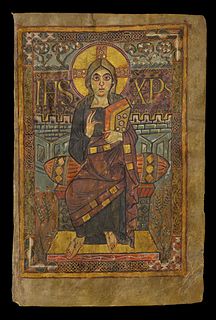
The Godescalc Evangelistary, Godescalc Sacramentary, Godescalc Gospels, or Godescalc Gospel Lectionary is an illuminated manuscript in Latin made by the Frankish scribe Godescalc and today kept in the Bibliothèque nationale de France. It was commissioned by the Carolingian king Charlemagne and his wife Hildegard on October 7, 781 and completed on April 30, 783. The Evangelistary is the earliest known manuscript produced at the scriptorium in Charlemagne's Court School in Aachen. The manuscript was intended to commemorate Charlemagne's march to Italy, his meeting with Pope Adrian I, and the baptism of his son Pepin. The crediting of the work to Godescalc and the details of Charlemagne's march are contained in the manuscript's dedication poem.
An itinerant is a person who travels habitually. Itinerant may refer to:

Lorsch Abbey, otherwise the Imperial Abbey of Lorsch, is a former Imperial abbey in Lorsch, Germany, about 10 km (6.2 mi) east of Worms. It was one of the most renowned monasteries of the Carolingian Empire. Even in its ruined state, its remains are among the most important pre-Romanesque–Carolingian style buildings in Germany. Its chronicle, entered in the Lorscher Codex compiled in the 1170s, is a fundamental document for early medieval German history. Another famous document from the monastic library is the Codex Aureus of Lorsch. In 1991 the ruined abbey was listed as a UNESCO World Heritage Site because of its architectural and historical importance.

Pre-Romanesque art and architecture is the period in European art from either the emergence of the Merovingian kingdom in about 500 AD or from the Carolingian Renaissance in the late 8th century, to the beginning of the 11th century Romanesque period. The term is generally used in English only for architecture and monumental sculpture, but here all the arts of the period are briefly described.
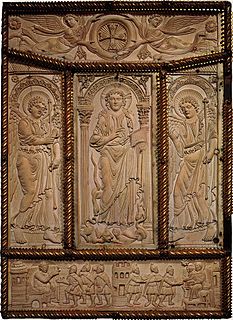
Carolingian art comes from the Frankish Empire in the period of roughly 120 years from about 780 to 900—during the reign of Charlemagne and his immediate heirs—popularly known as the Carolingian Renaissance. The art was produced by and for the court circle and a group of important monasteries under Imperial patronage; survivals from outside this charmed circle show a considerable drop in quality of workmanship and sophistication of design. The art was produced in several centres in what are now France, Germany, Austria, northern Italy and the Low Countries, and received considerable influence, via continental mission centres, from the Insular art of the British Isles, as well as a number of Byzantine artists who appear to have been resident in Carolingian centres.

Germigny-des-Prés is a commune in the Loiret department in north-central France.

Carolingian architecture is the style of north European Pre-Romanesque architecture belonging to the period of the Carolingian Renaissance of the late 8th and 9th centuries, when the Carolingian dynasty dominated west European politics. It was a conscious attempt to emulate Roman architecture and to that end it borrowed heavily from Early Christian and Byzantine architecture, though there are nonetheless innovations of its own, resulting in a unique character.

The Abbey of Saint John is an early medieval Benedictine monastery in the Swiss municipality of Val Müstair, in the Canton of Graubünden. By reason of its exceptionally well-preserved heritage of Carolingian art, it has been a UNESCO World Heritage Site since 1983.

Theodulf of Orléans was a writer, poet and the Bishop of Orléans during the reign of Charlemagne and Louis the Pious. He was a key member of the Carolingian Renaissance and an important figure during the many reforms of the church under Charlemagne, as well as almost certainly the author of the Libri Carolini, "much the fullest statement of the Western attitude to representational art that has been left to us by the Middle Ages". He is mainly remembered for this and the survival of the private oratory or chapel made for his villa at Germigny-des-Prés, with a mosaic probably from about 806. It was in Bible manuscripts produced under his influence that the Book of Baruch and the Letter of Jeremiah became part of the Western (Vulgate) Bible canon.
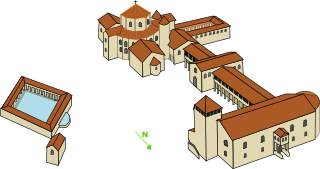
The Palace of Aachen was a group of buildings with residential, political and religious purposes chosen by Charlemagne to be the centre of power of the Carolingian Empire. The palace was located at the north of the current city of Aachen, today in the German Land of North Rhine-Westphalia. Most of the Carolingian palace was built in the 790s but the works went on until Charlemagne's death in 814. The plans, drawn by Odo of Metz, were part of the programme of renovation of the kingdom decided by the ruler. Today much of the palace is destroyed, but the Palatine Chapel has been preserved and is considered as a masterpiece of Carolingian architecture and a characteristic example of architecture from the Carolingian Renaissance.
Peter of Pisa, also known as Petrus Grammaticus, was an Italian grammarian, deacon and poet in the Early Middle Ages. In 776, after Charlemagne's conquest of the Lombard Kingdom, Peter was summoned to the Carolingian court along with Paul the Deacon and Alcuin. Peter had originally taught at Pavia, in Italy. Peter of Pisa was asked to be Charlemagne’s primary Latin teacher. Peter’s poetry provides a personal look at the workings of the innermost sanctum surrounding Charlemagne. Peter’s grammar texts provide insight into the transformation Latin education underwent in this period.

Eudesof Metz (742–814) was an architect who lived during Charlemagne's reign in the Carolingian Empire, and is the earliest known architect born north of the Alps. He was of Armenian origin.

There was an Abbasid–Carolingian alliance during the 8th and 9th centuries, effected through a series of embassies, rapprochements and combined military operations between the Frankish Carolingian Empire and the Abbasid Caliphate.
The Admonitio generalis is a collection of legislation known as a capitulary issued by Charlemagne in 789, which covers educational and ecclesiastical reform within the Frankish kingdom. Capitularies were used in the Frankish kingdom during the Carolingian dynasty by government and administration bodies and covered a variety of topics, sorted into chapters. Admonitio generalis is actually just one of many Charlemagne's capitularies that outlined his desire for a well-governed, disciplined Christian Frankish kingdom. The reforms issued in these capitularies by Charlemagne during the late 8th century reflect the cultural revival known as the Carolingian Renaissance.
The medieval renaissances were periods characterised by significant cultural renewal across medieval Western Europe. These are effectively seen as occurring in three phases - the Carolingian Renaissance, Ottonian Renaissance and the Renaissance of the 12th century.